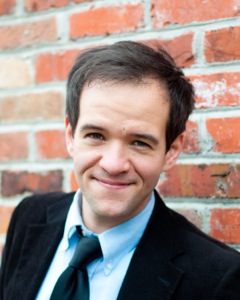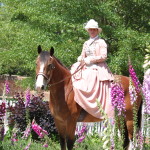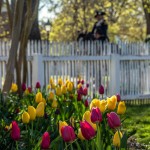
It is one of the greatest selling points of The Revolutionary City. Along a single-mile stretch of road, guests can lose themselves amidst the sights, smells, wisdom, and action of an historic 18th-century capital, come to life.
Colonial Williamsburg is a city of historians, artisans, experts, and performers. We are all bound for the singular purpose of passing on our history, heritage, and humanity in a way that is always inclusive, provocative, and personal. Yet, across the many acres that make up the Historic Area—in the outskirts surrounding the livestock, interpreters, and curious visitors, sit some silent citizens of the town that are often overlooked. That is, except for maybe the spring and fall when they decide to showcase their natural wonder.
I am, of course, referring to our trees! They are an attraction unto themselves in this curious little town of ours. So if you’re a lover of 18th-century naturalism, or just possess the brilliant wisdom to appreciate flowers in spring (and the patience to forgive the pollen), I’d love to share with you a little history of these large inhabitants and how these past four months of research have given me a whole new appreciation for this unique city we love.
Our 18th-century neighbors had deep and diverse cultural roots in the flora that surrounded them. For the British Colonists, songs about “the holly and the ivy” and “hearts of oak” echoed through homes and taverns along with one hundred and one other tunes. And by the time of the Revolution, the field of botany had blossomed to become the armchair hobby of many of our Nation’s founders, including the great little Madison.
My personal desire to begin researching the local flora came from the same place that most sparks of imagination originate here—a desire to teach it to the public. Playing James Madison, who possessed a brilliant mind for agriculture and the natural world, I thought it would be a neat opportunity to write a program focusing on the trees in the city and their history. And now, I lead a walking tour called “Founder’s Flora” on select Fridays from 11:45 - 12:45.
It was during our “January pause” when every interpreter’s nose found shelter in books, that I began studying 18th-century botany and naturalism. Once the steam stopped spewing from my ears, I became instantly enchanted. To my delight, I discovered that Williamsburg, in addition to being at the heart of the Revolution in Virginia, can also stake a claim in playing host to brilliant minds of the Enlightenment who made huge contributions to the budding (ha!) field of botany in the 18th century. Men like John Clayton, Mark Catesby, and even Dr. Franklin (the one time he passed through Virginia), walked these colonial streets and over the course of their lives, contributed to huge leaps in the field of botany. For example, the whole genus Claytonia which holds 26 species of plant is named in honor of John Clayton. It’s a nod to his efforts and contributions in gathering, studying, and sending specimens of native plants to Europe.
While Colonial Williamsburg tries to represent as closely as possible the town as it was in the 18th century, there are some major differences between the city then vs. now. Aside from the streets, which would have obviously been dirt, Williamsburg as the colonial capital had a fraction of the number of trees we have today. For a good representation of the town, you can visit our Virtual Williamsburg site created by the folks at the Digital History Center. When the decision was made to bring the city back to life, rather than trying to capture a photo likeness of the town as it was, it was decided instead that in addition to interpreting these buildings which were so important to our past, we should include a proper representation of the natural world. So, in the spirit of brevity, here are some of the giants that captured the attention of our past and are present in the city today.
The Northern Catalpa Tree (Catalpa speciosa,)
The Catalpa is probably one of the more infamous trees in the city, and represents one of the first government-funded tree planting in a city in British North America. On December 15, 1737 an invoice was drafted saying “that there be paid to Mr. Phillip Fench the Sum of Ten pounds for the laying and planting the Avenue to the Governors House”. While the invoice never said what was planted, an account in 1782 by General de Lauberdiere from France wrote in his journal “The Governor of Virginia also had a very fine palace, built at the extremity of a handsome street planted with Catalpas.” These can be found all the way down Palace Green framing the Palace.
Eastern hemlock (Tsuga canadensis)
A tree far from its native soil of South Carolina, this feathery evergreen was used as a source of tannin in the production of leather. A beautiful example can be found near the Secretary’s Office by the Capitol.
Southern Magnolia (Magnolia Grandiflora)
A true American wonder, the Magnolia is one of the most prized and admired native flowering trees. It is evergreen and flowers huge blooms late in the season. Several can be found on the west end of Nicholson Street and on the canal at the Governor’s Palace
American Beech (Fagus Grandifolia)
One of my favorite trees, the beech gets its name from the Old English word “Beec” which later became “Boc” and finally “book” in modern English. For thousands of years, people have used the soft wood of this stately tree to carve their inititals, landmarks, and lore. In Shakespeare’s As you Like It, the lover Orlando offers this:
O Rosalind! These trees shall be my books
And I their bark my thoughts I’ll character
That every eye which in this forest looks
Shall see thy virtue witness’s everywhere
The Arbor in the gardens of the Governors Palace are made from American Beech, and bear the inscriptions of many visitors!
Guest Blogger: Bryan Austin

Bryan has had the pleasure of being with Colonial Williamsburg for four years and the privilege of portraying James Madison, the eventual fourth president of the United States, and the Father of the Constitution. Before coming to CW, he worked as a professional actor across the country—doing everything from Shakespeare, puppetry, trapeze—even directing! What drew him here most were the stories and the unique blend of performance and scholarship you’ll find nowhere else in the world.
Bryan lives in the Historic Area of CW with his bride-to-be, dog, and books—enjoying all the aspects of a Revolutionary City lifestyle with, thankfully, all the modern amenities. Like his 18th-century partner in crime Madison, Bryan enjoys walks in nature and tucking into a good, long book.


jual bibit bunga teratai says
I’m very happy to find this page. I need to
to thank you for ones time due to this fantastic read!! I definitely loved every little bit of it and I have you book
marked to check out new stuff on your web site.
jual bibit bunga teratai says
An impressive share! I have just forwarded this onto a friend who was conducting a little research on this.
And he actually bought me lunch because I stumbled upon it
for him… lol. So allow me to reword this…. Thank YOU for the meal!!
But yeah, thanx for spending some time to talk about this subject here on your website.
jual bibit ikan says
Hi, its good article regarding media print,
we all understand media is a great source of data.
jual bibit bunga says
It’s very a nice and useful piece of article.
I am glad hat you
shared thiis helpful information with us. Please keep us
up to date lkke this. Thanks for sharing. jual bibit bunga
Wonderful! It seems so much good came from that January break!
The January Break did help create some wonderful new programs. It was a good idea. But consider having most things being open on MLK weekend in January due to kids being out of school it would be a good winter trip time. I so love these history information sessions led by the nation builder characters. I hope to catch this program on my next trip..
i would love to take this tour with you mr. Austin.! I plan to make it happen ! this was a very well written blog . I enjoyed reading it and learned a few things from it. there is always something new to see do or learn every visit to the colonial city and I am looking forward to taking advantage of this new opportunity.
Love these blogs! (But I wouldn’t have included the bit about the “inscriptions of many visitors!” in the trees in the Governor’s Palace gardens - NOT behaviour that should be encouraged! But hopefully the readers here are the kinds of folks who would never dream of following in the footsteps of previous vandals!
CW is like a never ending story. Just when the visitor , tourist or long term resident thinks they have seen it all, up pops a new chapter. I’ll keep reading